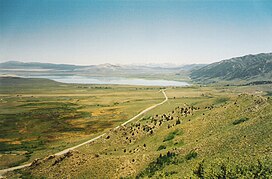| Mono Basin | |
|---|---|
 Mono Basin from near Conway Summit. | |
| Floor elevation | 6,380 feet (1,940 m) |
| Area | 631 to 801 square miles (1,630 to 2,070 km2) |
| Depth | 6,680 feet (2,040 m) |
| Geography | |
| Location | Mono County, California, United States |
| Borders on | W:
Sierra Crest N: Bodie Hills E: Cowtrack Mountains S: Long Valley Caldera [1] |
| Coordinates | 37°57′N 118°57′W / 37.950°N 118.950°W [2] |
The Mono Basin is an endorheic drainage basin located east of Yosemite National Park in California and Nevada. [3] [4] It is bordered to the west by the Sierra Nevada, to the east by the Cowtrack Mountains, to the north by the Bodie Hills, and to the south by the north ridge of the Long Valley Caldera. [1]
Estimates of the size of the basin range from 634 to 801 square miles, and the basin's elevation ranges from around 6,380 feet (level of Mono Lake as of 1986) to 13,061 feet atop Mount Dana near the Sierra Crest. [5] [6] [7]
Notable features in the basin include Mono Lake and the Mono-Inyo Craters, as well as the town of Lee Vining.
Geology
Geologically the basin is a structural basin that is bordered to the west by the frontal fault of the Sierra Nevada. The basin is part of the Walker Lane, an area where much of the deformation between the North American Plate and the Pacific Plate occurs. [8]
The basin was formed by geological forces over the last five million years: basin and range crustal stretching and associated volcanism and faulting at the base of the Sierra Nevada. [9]: 45

From 4.5 to 2.6 million years ago, large volumes of basalt were extruded around what is now Cowtrack Mountain (east and south of Mono Basin); eventually covering 300 square miles (780 km2) and reaching a maximum thickness of 600 feet (180 m). [9]: 45 Later volcanism in the area occurred 3.8 million to 250,000 years ago. [9]: 46 This activity was northwest of Mono Basin and included the formation of Aurora Crater, Beauty Peak, Cedar Hill (later an island in the highest stands of Mono Lake), and Mount Hicks.[ citation needed]
Lake Russell was the prehistoric predecessor to Mono Lake, during the Pleistocene. Its shoreline reached the modern-day elevation of 2,280 metres (7,480 ft), about 330 metres (1,100 ft) higher than the present-day lake. As of 1.6 million years ago, Lake Russell discharged to the northeast, into the Walker River drainage. After the Long Valley Caldera eruption 760,000 years ago, Lake Russell discharged into Adobe Lake to the southeast, then into the Owens River, and eventually into Lake Manly in Death Valley. [10] Prominent shore lines of Lake Russell, called strandlines by geologists, can be seen west of Mono Lake. [11]
Mono Basin is currently geologically active. Volcanic activity is related to the Mono-Inyo Craters: the most recent eruption occurred 350 years ago, resulting in the formation of Paoha Island. [12] Panum Crater is an example of a combined rhyolite dome and cinder cone. [13]
See also
Footnotes
- ^ a b Mono Basin, Mono County, California
- ^ "Mono Basin". Geographic Names Information System. United States Geological Survey, United States Department of the Interior.
- ^ Mono Basin Ecosystem Study Committee, National Research Council (1987). The Mono Basin ecosystem : effects of changing lake level. Washington, D.C.: National Academy Press. p. 1. ISBN 978-0-309-03777-8. Retrieved 28 January 2011.
- ^ Schweich, Tom. "Overview Map of Mono Basin". Eastern Mojave Vegetation. Retrieved 28 January 2011.
- ^ Mono Basin Ecosystem Study Committee, National Research Council (1987). The Mono Basin ecosystem : effects of changing lake level. Washington, D.C.: National Academy Press. p. 13. ISBN 978-0-309-03777-8. Retrieved 28 January 2011.
- ^ "Mono Basin EIR" (PDF). May 1993. p. 3A–6. Retrieved 28 January 2011.
- ^ "Mount Dana". NGS Data Sheet. National Geodetic Survey, National Oceanic and Atmospheric Administration, United States Department of Commerce.
- ^ Jayko, Angela. "Geology of Federal Lands in the Eastern Sierra Region, southwestern Great Basin". Geology of Parks and Federal Lands of the Southwest. USGS. Retrieved 2013-02-14.
- ^ a b c Tierney, Timothy (2000). Geology of the Mono Basin (revised ed.). Lee Vining, California: Kutsavi Press, Mono Lake Committee. pp. 45–46. ISBN 0-939716-08-9.
- ^ Reheis, MC; Stine, S; Sarna-Wojcicki, AM (2002). "Drainage reversals in Mono Basin during the late Pliocene and Pleistocene". Geological Society of America Bulletin. 114 (8): 991. Bibcode: 2002GSAB..114..991R. doi: 10.1130/0016-7606(2002)114<0991:DRIMBD>2.0.CO;2.
- ^ "Mono Lake". Long Valley Caldera Field Guide. USGS. Archived from the original on 2014-12-29. Retrieved 2015-01-13.
- ^ "Mono-Inyo Craters". USGS. Retrieved 2023-05-31.
- ^ "Long Valley Caldera Field Guide - Panum Crater". USGS. Retrieved 2023-05-09.
References
- Hill, Mary (2006). Geology of the Sierra Nevada. California Natural History Guides. Vol. 80 (2nd ed.). University of California Press.
- Tierney, Timothy (2000). Geology of the Mono Basin (revised ed.). Lee Vining, California: Kutsavi Press, Mono Lake Committee. ISBN 0-939716-08-9.